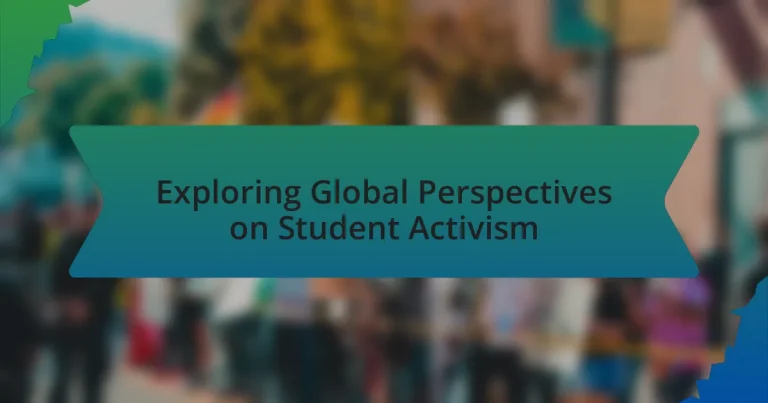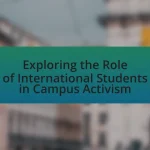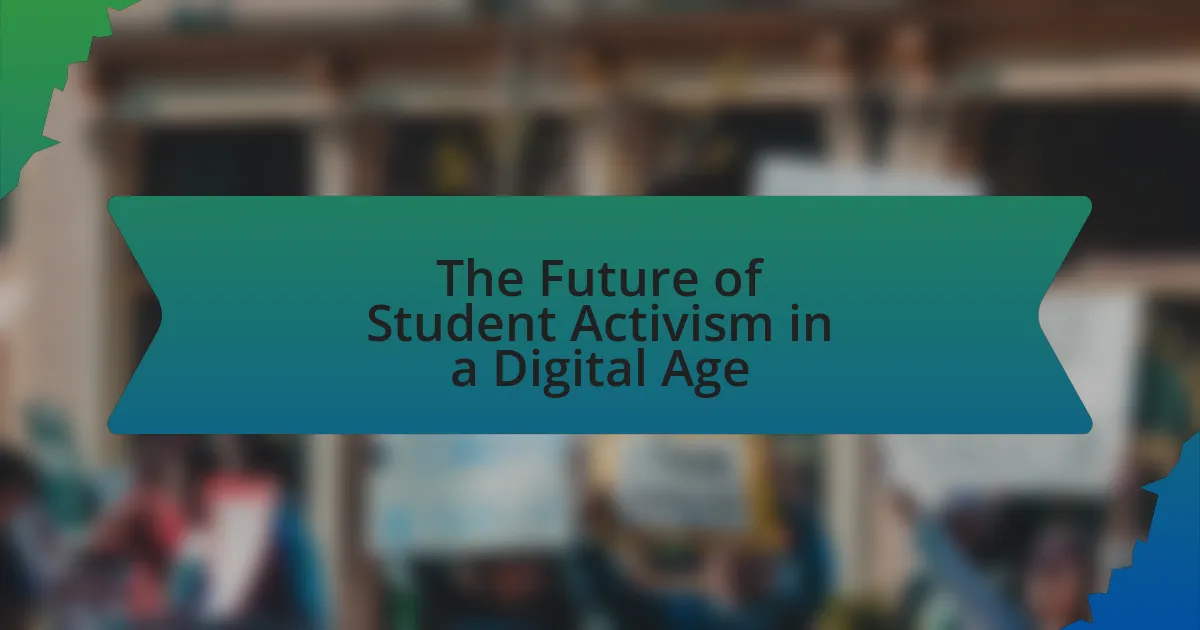Student activism in a global context encompasses organized efforts by students to advocate for social, political, and environmental change across various countries. The article explores the evolution of student activism, highlighting historical events that have shaped its trajectory, such as the civil rights movement and the anti-apartheid struggle. It examines the influence of cultural differences on activism, the importance of student-led initiatives in contemporary society, and the diverse forms of activism worldwide, including protests and advocacy campaigns. Additionally, the article addresses the challenges faced by student activists, including governmental repression and socioeconomic factors, while outlining effective strategies for mobilization and collaboration.
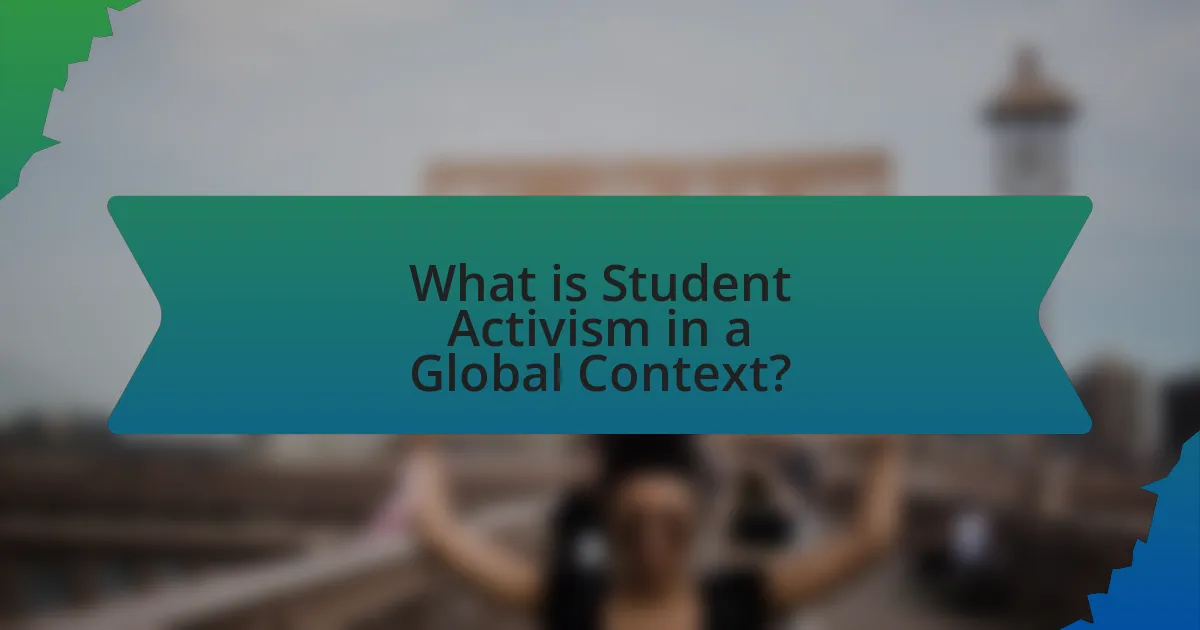
What is Student Activism in a Global Context?
Student activism in a global context refers to the organized efforts by students to advocate for social, political, and environmental change across various countries. This form of activism has historically played a significant role in shaping policies and societal norms, as seen in movements such as the 1960s civil rights protests in the United States and the anti-apartheid movement in South Africa, where student-led initiatives were pivotal in mobilizing public opinion and influencing legislative reforms. Globally, student activism addresses issues like climate change, education reform, and human rights, demonstrating a collective commitment to societal improvement and reflecting diverse cultural and political landscapes.
How has student activism evolved over time?
Student activism has evolved from localized movements focused on specific issues to a global phenomenon addressing a wide range of social, political, and environmental concerns. In the 1960s, student activism was characterized by protests against the Vietnam War and civil rights movements in the United States, exemplified by events like the 1968 Democratic National Convention protests. Over the decades, this activism expanded to include issues such as climate change, gender equality, and racial justice, with movements like the March for Our Lives and Fridays for Future gaining international traction. The rise of social media has further transformed student activism, enabling rapid organization and global solidarity, as seen in the Arab Spring and Black Lives Matter movements. This evolution reflects a shift from national concerns to a more interconnected approach, where students worldwide collaborate to address systemic injustices.
What historical events have shaped student activism globally?
Historical events that have shaped student activism globally include the May 1968 protests in France, the Tiananmen Square protests in China in 1989, and the anti-apartheid movement in South Africa during the 1980s. The May 1968 protests involved widespread student demonstrations against capitalism and consumerism, leading to significant social and political changes in France. The Tiananmen Square protests were a pivotal moment in China’s history, where students demanded democratic reforms, resulting in a violent government crackdown. The anti-apartheid movement saw students actively participating in protests against racial segregation, contributing to the eventual dismantling of apartheid in South Africa. These events illustrate the powerful role of student activism in advocating for social justice and political change across different contexts.
How do cultural differences influence student activism?
Cultural differences significantly influence student activism by shaping the values, priorities, and methods of engagement among students. For instance, in collectivist cultures, student activism often emphasizes community solidarity and collective action, as seen in countries like China and India, where group-oriented movements are prevalent. Conversely, in individualistic cultures such as the United States, activism may focus more on personal expression and individual rights, leading to diverse and decentralized movements. Research by the Institute for Social Research indicates that cultural context affects the motivations behind activism, with students in more hierarchical societies often advocating for systemic change through established institutions, while those in egalitarian societies may pursue grassroots initiatives. This demonstrates that cultural frameworks not only dictate the issues students prioritize but also influence the strategies they employ in their activism.
Why is student activism important in today’s society?
Student activism is important in today’s society because it empowers young individuals to advocate for social change and influence public policy. This engagement fosters critical thinking and civic responsibility among students, enabling them to address pressing issues such as climate change, racial inequality, and education reform. Historical examples, such as the 1960s civil rights movement and recent climate strikes led by youth activists like Greta Thunberg, demonstrate how student-led initiatives can mobilize communities and effect significant societal transformations. These movements not only raise awareness but also pressure governments and institutions to respond to the demands of the younger generation, highlighting the vital role of student activism in shaping a more equitable and sustainable future.
What role do students play in social and political change?
Students play a crucial role in social and political change by mobilizing movements, advocating for reforms, and influencing public policy. Historically, student activism has been a driving force in significant social movements, such as the Civil Rights Movement in the United States, where students organized protests and sit-ins to challenge racial segregation. In 1968, students in France led widespread protests that questioned authority and called for social change, demonstrating their ability to galvanize public sentiment. Furthermore, the global climate strikes initiated by students, particularly those inspired by Greta Thunberg, have raised awareness and pressured governments to take action on climate change. These examples illustrate that students not only participate in activism but also shape the political landscape through their collective actions and demands for justice and reform.
How does student activism impact educational institutions?
Student activism significantly impacts educational institutions by driving policy changes, promoting social justice, and fostering a culture of engagement. For instance, movements such as the 1960s civil rights protests led to the implementation of more inclusive curricula and diversity initiatives in universities across the United States. Additionally, recent student-led campaigns for climate action have prompted institutions to adopt sustainable practices and policies, reflecting a growing awareness of environmental issues. These actions demonstrate that student activism not only influences institutional governance but also shapes the educational landscape by encouraging dialogue and reform on critical societal issues.
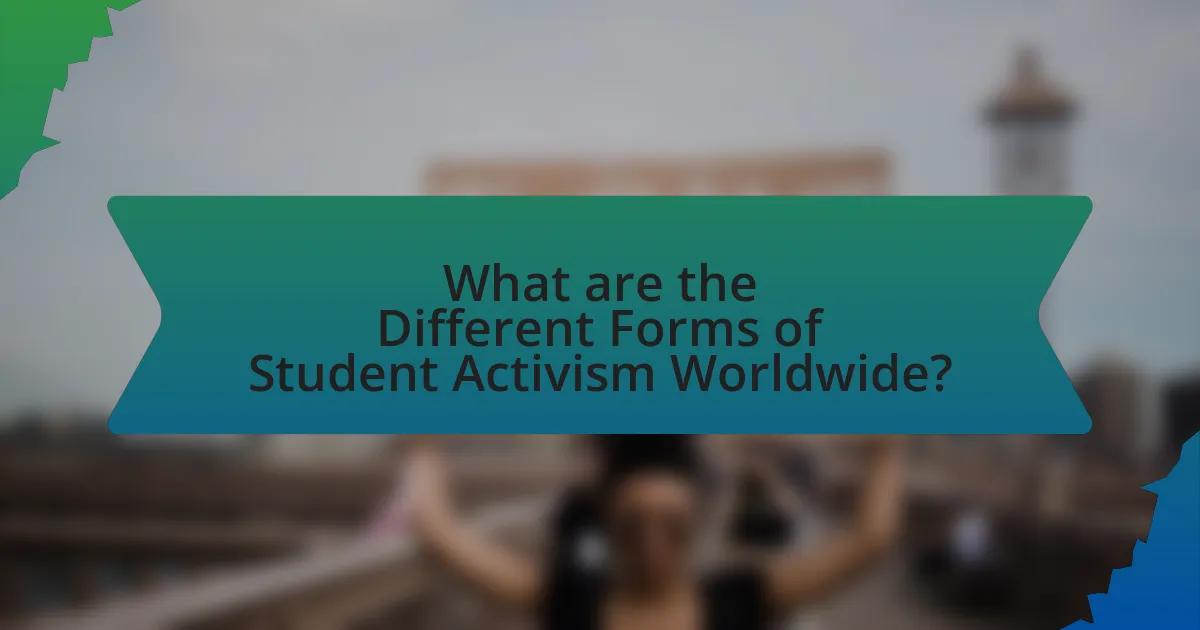
What are the Different Forms of Student Activism Worldwide?
Student activism worldwide manifests in various forms, including protests, advocacy campaigns, and organized movements. Protests often involve demonstrations against government policies or social injustices, such as the 2019 climate strikes led by students globally, which mobilized millions to demand action on climate change. Advocacy campaigns focus on specific issues, such as tuition fees or educational reforms, exemplified by the #FeesMustFall movement in South Africa, which sought to address the rising costs of higher education. Organized movements, like the March for Our Lives in the United States, highlight student-led initiatives aimed at gun control and school safety. These forms of activism demonstrate the diverse ways students engage in social and political issues, reflecting their influence and commitment to change.
How do protests and demonstrations manifest in various countries?
Protests and demonstrations manifest in various countries through diverse forms, including peaceful marches, sit-ins, and online activism. For instance, in the United States, protests often take the shape of large-scale marches, such as the Women’s March or Black Lives Matter demonstrations, which mobilize thousands of participants advocating for social justice and policy changes. In contrast, countries like Iran experience protests that can escalate into violent confrontations with authorities, as seen during the 2019 fuel price protests, where widespread unrest led to significant casualties and government crackdowns. Additionally, in countries like Hong Kong, protests have included unique elements such as the use of umbrellas for protection against police tactics, highlighting the innovative strategies employed by activists. These manifestations reflect the cultural, political, and social contexts of each nation, influencing how citizens express dissent and demand change.
What are some notable examples of student-led protests?
Notable examples of student-led protests include the Tiananmen Square protests in 1989, where students in China demanded political reform and greater freedoms, culminating in a violent crackdown by the government. Another significant instance is the March for Our Lives movement in 2018, initiated by students from Stoneman Douglas High School in the United States, advocating for gun control following a tragic school shooting. Additionally, the 1968 student protests in France, known as May 68, involved widespread demonstrations against capitalism and traditional societal norms, leading to significant political and social changes. Each of these protests exemplifies the power of student activism in shaping societal discourse and policy.
How do government responses to student protests vary globally?
Government responses to student protests vary significantly across the globe, influenced by political systems, cultural contexts, and historical precedents. In democratic nations like the United States, governments often engage in dialogue with student leaders and may implement policy changes in response to protests, as seen during the 1960s civil rights movement and more recently with climate activism. Conversely, authoritarian regimes, such as in China, typically respond with repression, employing tactics like censorship, arrests, and violent crackdowns, exemplified by the Tiananmen Square protests in 1989. In countries like Brazil, responses can oscillate between negotiation and force, depending on the political climate and the nature of the protests, as observed during the 2013 protests against public transport fare hikes. Thus, the variation in government responses is shaped by the interplay of governance styles, societal values, and the specific demands of the student movements.
What role does technology play in modern student activism?
Technology plays a crucial role in modern student activism by facilitating communication, organization, and mobilization. Digital platforms such as social media enable students to share information rapidly, connect with like-minded individuals, and coordinate events on a large scale. For instance, the use of Twitter and Instagram during the 2018 March for Our Lives movement allowed students to amplify their message for gun control, reaching millions globally within hours. Additionally, online petitions and crowdfunding platforms have empowered students to raise awareness and funds for their causes efficiently. The ability to disseminate information quickly and engage a broader audience has transformed traditional activism into a more dynamic and impactful movement.
How has social media changed the landscape of student activism?
Social media has significantly transformed the landscape of student activism by providing a platform for rapid communication and mobilization. This shift allows students to organize protests, share information, and raise awareness on social issues more efficiently than traditional methods. For instance, the #BlackLivesMatter movement gained momentum through social media, enabling students to connect across geographical boundaries and amplify their voices. Research indicates that 79% of young activists believe social media is crucial for their efforts, highlighting its role in fostering community and solidarity among students.
What are the risks and benefits of online activism for students?
Online activism for students presents both significant benefits and notable risks. The benefits include increased awareness and engagement on social issues, as students can easily mobilize support and share information through social media platforms, leading to greater visibility for their causes. For instance, the #MeToo movement gained traction online, highlighting issues of sexual harassment and empowering students to speak out.
Conversely, the risks involve potential backlash and online harassment, as students may face negative consequences for their activism, including cyberbullying or academic repercussions. A study by the Pew Research Center found that 41% of young adults have experienced online harassment, which can deter students from participating in activism. Additionally, the spread of misinformation can undermine legitimate causes, as seen in various social media campaigns where false narratives have led to public confusion and discrediting of movements.
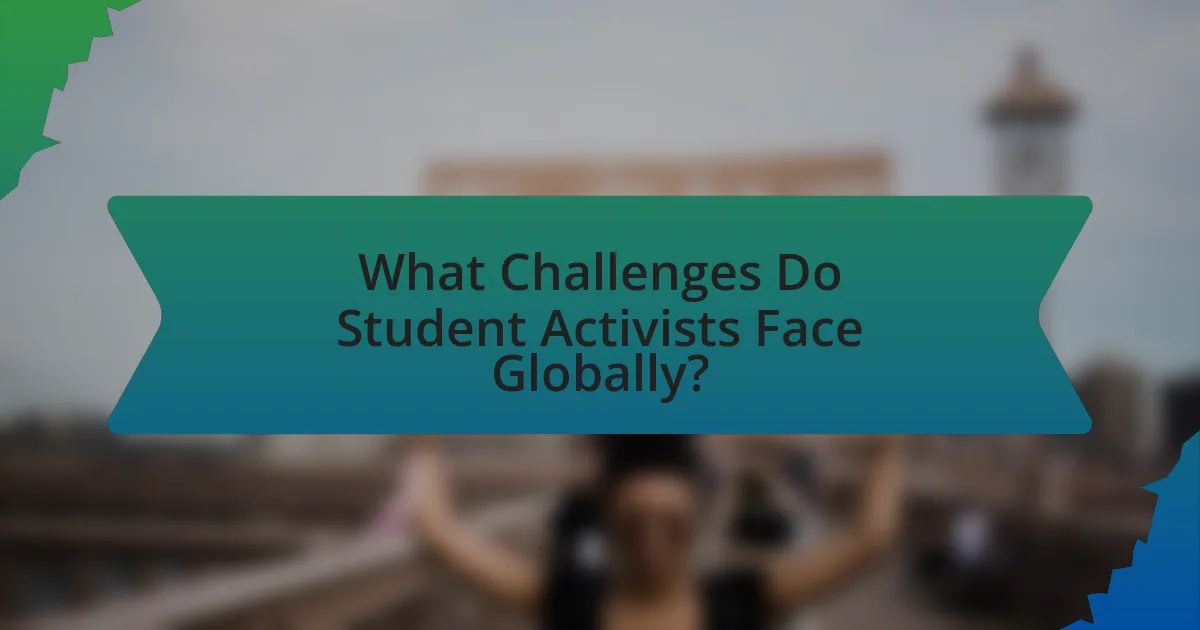
What Challenges Do Student Activists Face Globally?
Student activists face numerous challenges globally, including governmental repression, lack of resources, and social stigma. Governmental repression often manifests as censorship, arrests, or violence against student movements, as seen in countries like Iran and Belarus, where protests have been met with severe crackdowns. Additionally, many student activists struggle with limited access to funding and organizational support, which hampers their ability to mobilize effectively. Social stigma can also pose a significant barrier, as students may face backlash from peers, families, or institutions for their activism, leading to isolation or diminished support. These challenges collectively hinder the effectiveness and sustainability of student activism worldwide.
What legal and political obstacles do student activists encounter?
Student activists encounter various legal and political obstacles, including restrictive laws, government repression, and institutional barriers. For instance, many countries impose laws that limit freedom of assembly and expression, making it difficult for student groups to organize protests or express dissenting opinions. In some cases, governments may respond to activism with intimidation, surveillance, or even violence, as seen in countries like Iran and China, where student protests have been met with severe crackdowns. Additionally, universities may have policies that restrict political activities on campus, further hindering students’ ability to mobilize and advocate for change. These obstacles collectively create an environment that can stifle student activism and limit its effectiveness.
How do different governments respond to student activism?
Different governments respond to student activism through a range of strategies, including repression, dialogue, and policy changes. For instance, authoritarian regimes often suppress student movements through censorship, arrests, and violence, as seen in countries like Iran and China, where protests have been met with severe crackdowns. Conversely, democratic governments may engage in dialogue with student activists, leading to policy reforms, as observed in countries like Canada and Sweden, where student demands have influenced educational policies. Additionally, some governments may adopt a mixed approach, initially repressing protests but later conceding to demands to maintain social stability, exemplified by the responses in France during the 2018 student protests against educational reforms.
What are the consequences of repression on student movements?
Repression on student movements leads to increased radicalization and a decline in participation. When authorities suppress student activism through violence, censorship, or intimidation, students often respond by adopting more extreme measures or ideologies, as seen in the Tiananmen Square protests of 1989, where initial peaceful demonstrations escalated into a call for broader political reform after violent repression. Additionally, repression can deter participation in future movements, as fear of repercussions discourages students from engaging in activism, evidenced by the decline in protests in countries with heavy-handed government responses, such as Egypt post-2011. This cycle of repression and radicalization can ultimately undermine the legitimacy of the government and lead to long-term social unrest.
How do socioeconomic factors influence student activism?
Socioeconomic factors significantly influence student activism by shaping students’ access to resources, education, and opportunities for engagement. Students from lower socioeconomic backgrounds often face systemic barriers that can motivate them to advocate for social change, as they may experience firsthand the impacts of inequality, such as inadequate educational facilities or limited job prospects. For instance, research conducted by the Pew Research Center indicates that students from lower-income families are more likely to participate in protests and movements aimed at addressing social justice issues, reflecting their urgent need for change in their circumstances. Additionally, socioeconomic status affects students’ ability to mobilize, as those with more financial resources may have greater access to networks and platforms for activism, while economically disadvantaged students may rely on grassroots organizing to amplify their voices.
What impact does access to education have on student activism?
Access to education significantly enhances student activism by equipping individuals with critical thinking skills, awareness of social issues, and the ability to organize effectively. Educated students are more likely to engage in activism as they understand their rights and the mechanisms of change. For instance, a study by the Institute for Democracy and Electoral Assistance found that higher education levels correlate with increased political participation among youth, demonstrating that access to education fosters a more informed and active student body. This connection underscores the role of education in empowering students to advocate for social justice and policy reform.
How do economic disparities affect the effectiveness of student movements?
Economic disparities significantly hinder the effectiveness of student movements by limiting access to resources, participation, and organization. Students from lower socioeconomic backgrounds often face financial constraints that restrict their ability to engage in activism, such as affording transportation, materials, or time away from work. For instance, a study by the Institute for Policy Studies found that students from low-income families are less likely to participate in protests compared to their wealthier peers, as they prioritize immediate economic survival over activism. Additionally, economic disparities can lead to a lack of representation within student movements, as those with fewer resources may not have their voices heard or their issues prioritized, ultimately weakening the collective impact of the movement.
What strategies can student activists employ for success?
Student activists can employ strategies such as building coalitions, utilizing social media, and engaging in direct action to achieve success. Building coalitions with diverse groups enhances the reach and impact of their initiatives, as seen in the 2019 climate strikes where students collaborated with environmental organizations to amplify their message. Utilizing social media platforms allows activists to mobilize support quickly and effectively; for instance, the #NeverAgain movement leveraged Twitter to organize rallies and share information, resulting in significant public engagement. Engaging in direct action, such as protests or sit-ins, can draw attention to their causes, exemplified by the 1960s civil rights sit-ins that successfully challenged segregation laws. These strategies, when implemented effectively, can lead to meaningful change and increased visibility for student-led movements.
How can collaboration with other organizations enhance student activism?
Collaboration with other organizations can enhance student activism by providing access to additional resources, expertise, and networks. When student groups partner with established organizations, they can leverage these entities’ experience in advocacy, which can lead to more effective campaigns. For instance, a study by the National Student Leadership Conference found that student organizations that collaborated with non-profits reported a 40% increase in their ability to mobilize peers for social causes. This collaboration not only amplifies the reach of student initiatives but also fosters a sense of solidarity and shared purpose, ultimately strengthening the impact of their activism.
What are effective communication strategies for student movements?
Effective communication strategies for student movements include utilizing social media platforms, organizing face-to-face meetings, and creating clear messaging. Social media enables rapid dissemination of information and mobilization of supporters, as evidenced by the role of Twitter in the Arab Spring, where it facilitated real-time updates and coordination among activists. Face-to-face meetings foster community building and trust, allowing for deeper discussions and strategic planning. Clear messaging ensures that the movement’s goals and demands are easily understood, which is crucial for garnering public support and media attention, as seen in the clarity of the messaging during the March for Our Lives campaign advocating for gun control.
What lessons can be learned from global student activism?
Global student activism teaches the importance of collective action and the power of youth voices in driving social change. Historical examples, such as the 1960s civil rights movement in the United States and the 2019 climate strikes led by students worldwide, demonstrate that organized efforts can influence policy and raise awareness on critical issues. These movements often highlight the effectiveness of social media in mobilizing support and disseminating information rapidly, as seen in the #FridaysForFuture campaign initiated by Greta Thunberg. Additionally, global student activism underscores the necessity of intersectionality, as diverse groups unite to address overlapping social justice issues, thereby amplifying their impact.
How can past student movements inform future activism?
Past student movements can inform future activism by providing valuable lessons in organization, strategy, and the importance of solidarity. Historical examples, such as the 1960s Civil Rights Movement in the United States, demonstrate how student-led initiatives can catalyze broader social change, as seen with the involvement of students in sit-ins and protests that challenged segregation. Additionally, the anti-apartheid movement in South Africa showcased the power of global student solidarity, where international student organizations mobilized to support local activists, emphasizing the effectiveness of cross-border alliances. These movements illustrate that understanding past successes and failures can guide contemporary activists in crafting effective strategies, mobilizing support, and sustaining momentum for their causes.
What best practices can student activists adopt from successful movements?
Student activists can adopt several best practices from successful movements, including building coalitions, utilizing social media effectively, and focusing on clear messaging. Successful movements, such as the Civil Rights Movement, demonstrated the power of coalition-building by uniting diverse groups to amplify their voices and increase their impact. For instance, the Student Nonviolent Coordinating Committee (SNCC) collaborated with various organizations to strengthen their efforts against racial injustice.
Additionally, effective use of social media has been pivotal in movements like the Arab Spring, where platforms facilitated rapid organization and information dissemination, allowing activists to mobilize quickly and reach a global audience. Clear messaging, as seen in the Women’s March, helps to articulate goals and rally support, ensuring that the movement’s objectives resonate with a broad audience. These practices have proven effective in enhancing the visibility and influence of student activism.
